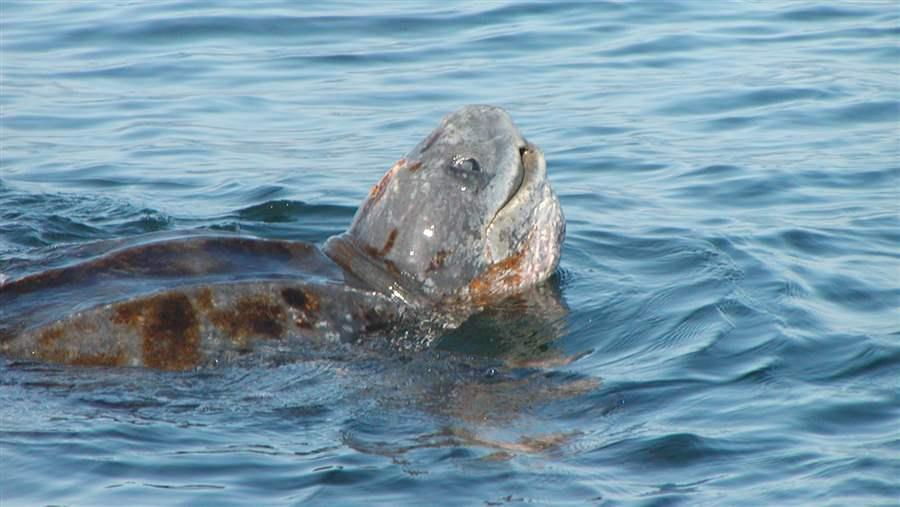Study Proposes Consistent Thresholds for Fishermen’s Catch of Vulnerable Species
 Scott Benson/NOAA
Scott Benson/NOAAA leatherback sea turtle in Monterey Bay, California
So tenuous is the state of the Pacific leatherback sea turtle that the accidental mortality of only seven individuals could conceivably shut down an entire fishery in California. A pair of new papers offers a way to set such thresholds for management action low enough to protect imperiled species, but not so low that fishermen face unfair or unnecessary shutdowns.
The leatherbacks that nest on western Pacific beaches migrate as far as 7,000 miles to feed in several areas, including off the U.S. West Coast. The population has dropped by 80 percent in recent decades, in large part due to accidental catch by fishermen.
A pair of papers published in September 2015 offers a standard for assessing when such human impacts may be cause for corrective action. The papers were published in Marine Policy and PLOS ONE and supported by the Lenfest Ocean Program.
“This research offers a method that can be applied consistently across species and management jurisdictions,” said Alexandra Curtis, the lead author and a researcher for the National Oceanographic and Atmospheric Administration (NOAA). “That may not sound exciting, but it basically means you’re conserving species while avoiding undue impacts on fishermen.”
The first paper outlines an approach for estimating a population’s maximum sustainable mortality, known as a limit reference point (LRP). Catch above this level would pose too high a risk of undesirable impacts. This approach can be used for all marine megafauna—including mammals, turtles, sharks, and birds. It has five steps:
- Define specific conservation objectives (including desired population level and risk tolerance)
- Choose a method of estimating the LRP
- Estimate population productivity
- Estimate abundance
- Use computer simulation to adjust the estimates for uncertainty and risk tolerance
The paper also offers ways to resolve common challenges. For example, when a population migrates across international boundaries, LRPs can be prorated based on how much of the population occurs in each area and by how long they stay. The resulting local LRPs would be consistent with the conservation objectives, but they would not be sufficient if other countries did not take similar steps.
The second paper applies this approach to western Pacific leatherbacks off the U.S. West Coast. It offers potential local LRPs based on different conservation objectives and different methods for estimating leatherback abundance.
This resulted in several estimated local LRPs, ranging from 0.8 turtles per five years to promote relatively fast population recovery, to 7.7 per five years to maintain a much lower but still viable level.
The current threshold of seven turtles per five years under the U.S. Endangered Species Act falls within this range, although it was not set using this approach. The authors say that their approach may provide useful information for such thresholds, but these require several other considerations.
“In this case, we found that current catch levels in the California drift gillnet fishery are within the range consistent with allowing this endangered species to recover slowly,” said co-author Jeffrey Moore, a researcher at NOAA. “But the systematic approach we have demonstrated gives us a better handle on the status of leatherbacks, and provides a powerful tool for distributing the burden of conservation to all countries and fishermen.”
About the Studies:
Curtis, K.A., J.E. Moore, C. Boyd, P.W. Dillingham, R.L. Lewison, B.L. Taylor, & K.C. James. “Managing catch of marine megafauna: guidelines for setting limit reference points. Marine Policy (2015), 61:249-263.
Curtis, K. A., J.E. Moore,& S.R. Benson. “Estimating limit reference points for western Pacific leatherback turtles (Dermochelys coriacea) in the US West Coast EEZ.” PLoS ONE (2015), 10(9), e0136452.


